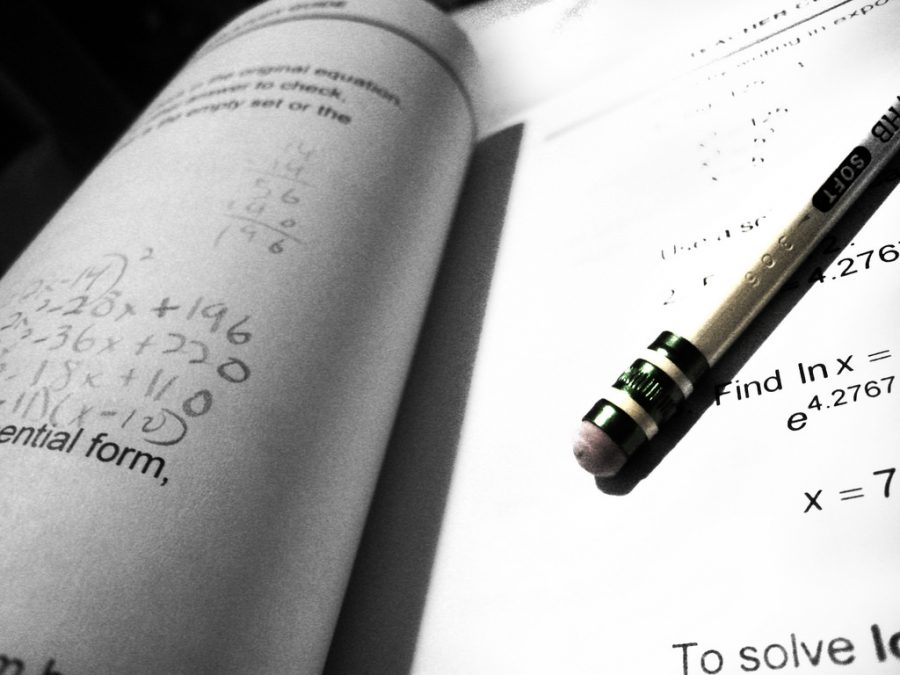Why the SAT Is a Poor Measurement of Students’ Academic Skills
May 9, 2018
For all underclassmen who are fortunate enough to have not taken the SAT, here is a little insight as to what to expect. Based on my experience last Saturday, May 5, I have come to the conclusion that the SAT is a poor way to measure a student’s academic skill and it should not play such an important role in deciding our futures. Here’s an overview of all of the issues involved in this taxing test.
What Is the SAT?
The SAT is a test in which students, predominantly juniors, participate in a grueling three hour exam, which is four hours if you include breaks and time spent sitting there filling in information bubbles. Less of a test than it is a bubble filling simulator, the SAT leaves students feeling exhausted and overworked from answering questions that are impossible to study for.
The SAT is separated into three main sections, four if you sign up to take the essay. The three main sections are reading, writing and literature, and math.
Each test varies in length. The writing and literature section has a total of forty-four questions and an allotted time of only thirty-five minutes to answer all of them. The reading section of the test has fifty-two questions with an allotted time of sixty-five minutes, and the math section has a grand total of fifty-eight questions with eighty minutes to answer every single one of them.
What’s the Difference Between the SAT and a Normal Test You Would Take in School?
The SAT’s biggest downfall is that it focuses on a such a wide period of curriculum, specifically what they think you should have learned in high school. It doesn’t matter whether or not you’ve ever learned the math that’s on the test, or if you’re ever going to use that math; all that matters is that you can answer the questions and get them right.
Focusing on several years worth of material rather than on a single chapter of a subject shows what a colossal monster of a test the SAT is.
The average test in high school is generally focused on one or two chapters of a subject that you have been learning for the past few weeks. The point of this type of test is to determine how well you grasp the concept of what you’ve been learning.
Another form of test that everyone takes in high school is a final. Everyone dreads finals, and for good reason. Finals alone are a huge chunk of material to study for. You’re tested on everything you’ve learned in the past semester, more than four months of material!
Instead, imagine being tested on several years worth of material.
The SAT is like a final times twelve. Think about every English and math final you’ve taken or are going to take, now cram them all into one gigantic test; now you’ve got the SAT.
How Do You Study for the SAT?
The literature and reading portions of the test were easy tasks, but those sections of the test weren’t what I was afraid of.
I spent three weeks studying for the SAT in my spare time, and most of that studying was done on math. After studying for the last time the night before the test, I felt as though I was prepared enough to take the test and do well.
However, once I was allowed to start the math portion of the test, it didn’t take long for me to realize that all of my studying was for nothing.
Studying for the SAT isn’t like studying for your average test. You don’t have the security of a teacher to ask questions of or the days of hands-on review leading up to it. You are left to your own methods and other limited ideas for studying recommended by The College Board. The College Board even offers a small 1,275 page study guide.
Not helpful.
However, The College Board does recommend using a website called Khan Academy.
I was already familiar with Khan Academy because I used the site’s variety of different videos to help me through my struggle with previous math classes. So it was easily my first choice when it came to the SAT.
The Khan Academy site that The College Board links you to is designed specifically for SAT preparation. It even gives you the option of letting the site review your previous PSAT scores so that your methods of studying are more personalized, focusing more on your weak subjects rather than the subjects that you tested strongly in.
I recommend this method of studying for any students who are preparing to take the SAT in the near future. The Khan Academy site is a true lifesaver; without it I surely would have scored a considerably lower score on my SAT.
But Khan Academy can only prepare you for so much.
What Is It Like to Take the Test?
Before even receiving your test booklet and answer sheet, the SAT is the most daunting obstacle in a teenager’s high school career. My entire teenage life, I’ve been constantly reminded that my future depends on the scores of my SAT. As if that wasn’t enough pressure, studying endlessly over years of forgotten curriculum, on top of the already exhausting workload that teachers assign to students — it is nauseating.
I quickly discovered that the hours of studying I had done in the previous weeks did not prepare me for the task at hand.
Walking into my test room was like waiting in line for a TSA check at the airport.
I lined up at the door and waited my turn with my admission confirmation ticket and valid ID held firmly in hand, as the weight of the stress slowly crushed my nerve.
After about fifteen minutes, which felt more like an hour, the proctor validated my ID and admission ticket, then proceeded to assign me to my seat. I quickly became acquainted with the rickety school desk and my classroom surrounding. I remember feeling a wave of relief wash over me as I settled into the familiar crease of the uncomfortably stiff desk chair.
The initial lag time between the proctor seating me and handing out test booklets acted as a brief moment of mental relief. Once the proctor had finished sentencing my fellow test takers to their very own rigid desks, he walked calmly to the front of the class room and announced six simple yet relieving words, “Your scores do not define you.” For a minute I was relieved, but then he began handing out the tests.
Once he had completed handing out the tests, he proceeded to read the script that all proctors were ordered to read. This is basically the same script of instructions that every student is accustomed to hearing at the beginning of every standardized test or PSAT.
The moment those words began to leave his mouth, his soothing voice slowly morphed into a jumbled inaudible series of murmurs. He sounded like an adult from an old episode of Charlie Brown.
Once he finished reciting the familiar, bland script, my heart began to race again.
“Open your test booklets and begin.”
This marked the beginning of my endless bubble filling and mentally taxing crucible of a test.
Three hours of non-stop bubble filling. That’s all it is, and yet your score can decide your future. It’s not fair.
Why Is the SAT a Terrible Way to Measure a Student’s Academic Skill?
The SAT focuses on years of previous and current curriculum. How is anyone supposed to remember everything that they learned in the past three to four years of their life even if it’s all written out in a 1,275 page study guide?
This was what I found to be the most irritating part of the test. I would often come across problems that I knew I had seen before, or at least a variation of it, yet for the life of me I couldn’t remember the simple formula to solve it. There is nothing more frustrating. Every test that I have ever taken whether it’s math or science, the formulas are always given.
That massive study guide was rendered completely useless once the test was in front of me. The hours of studying on Khan Academy couldn’t possibly help me. The SAT is just too much to study for.
This wouldn’t be a problem if the test wasn’t timed. Because the test is timed, problems that stump students can’t be solved through trial and error, leaving students with no other option than to guess.
Overall, having a timed test over years of curriculum isn’t helpful. The stress of taking a test that can determine your future is so incredibly anxiety-inducing that, even for solid test-takers, it destroys all confidence before even receiving the test.
There is no way to prepare for the SAT.
What Is the Possible Solution?
The SAT should not be such a vital part of getting into college.
I think that there should be less focus on test scores and more focus on student accomplishments in school. Much like what we do in the journalism community with our writing portfolios, students should have the opportunity to keep all of their work in a portfolio as well.
It is true that colleges look at much more than just SAT scores, but they are a major factor. If students had the opportunity to build a portfolio, much like building a resume, colleges would be able to follow the student’s progression and look at the work they’ve done.
Overall, putting less emphasis on the scores of the SAT and putting more focus on academic progression and achievement would be a better method for colleges to precisely measure a student’s real academic skill and potential.






Mary Humphrey Millard • May 12, 2018 at 4:16 pm
I am a LaSalle Alumni. An OLD one – I graduated in 1972. But I feel very strongly on the subject of SAT tests even now.
I wholeheartedly agree with Sam. The weight this test bears on a students’ future is Wrong. I never did well on Exams and the SAT was no exception – it’s a good thing I wasn’t set on attending college because my score likely would have been lethal for me. There should be other standards, and more practical ones, on which to base a students’ intellect. Life Experience would be a good place to start, followed by the Basics of what has been learned and Remembered those past 3-4 high school years.
Time to change these antiquated ways, Academia! It’s time to start being Fair!
Trey Dettmer • May 10, 2018 at 10:04 am
I definitely think the SAT is a bad way to test students. A single test should not be a factor when applying to colleges. GPA and other academic and portfolio related accomplishments should be the focus because they are a better representation of the student as a whole.
Madison York • May 10, 2018 at 12:23 am
I agree with you on this! Although I have noticed that many colleges are starting to offer a portfolio option if you don’t want to submit your SAT score. A follow up to the portfolio route should be having freshman start putting things away now for the future. I really enjoyed this article by the way!(:
sou • May 9, 2018 at 11:41 pm
Very well said Sam! I disliked taking it the first time … and second time… and third. Hope you get a good score!
Nicole Khoury • May 9, 2018 at 8:39 pm
Totally agree your solution Sam! I, too, thought I was prepared for the SAT, but the math sections always get me no matter how long I study or use Khan Academy for help. Great article and hopefully we get good scores:/